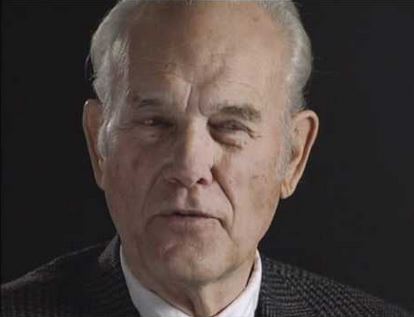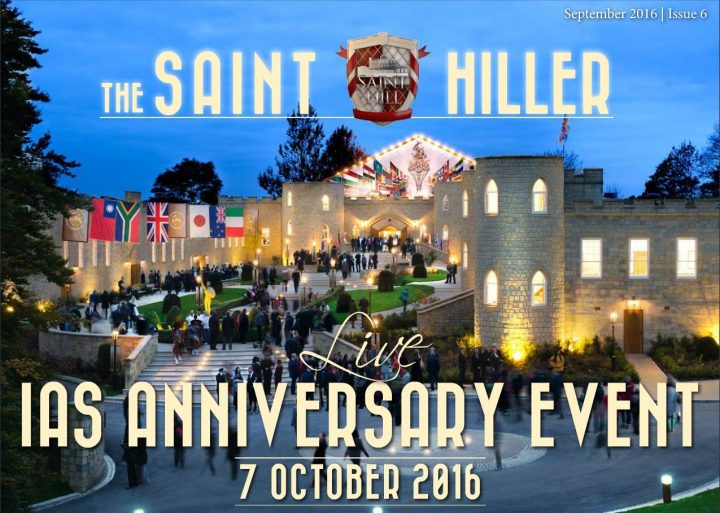 Jon Atack is the author of A Piece of Blue Sky, one of the very best books on L. Ron Hubbard and Scientology. He has a new edition of the book for sale, and for more than three years he’s been helping us sift through the legends, myths, and contested facts about Scientology that tend to get hashed and rehashed in books, articles, and especially on the Internet.
Jon Atack is the author of A Piece of Blue Sky, one of the very best books on L. Ron Hubbard and Scientology. He has a new edition of the book for sale, and for more than three years he’s been helping us sift through the legends, myths, and contested facts about Scientology that tend to get hashed and rehashed in books, articles, and especially on the Internet.
I want to expand on an earlier post about Leroy Fletcher Prouty, Scientology’s hired gun, who managed to trick many people into believing that L. Ron Hubbard was active in US Navy Intelligence.
My first task on leaving the mother cult was to understand why the friendly group to which I thought I had belonged for nine years had turned so very sour. The “dead-agent” pack produced by Scientology about me says that I objected to the “tough and ruthless” attitude of the new leadership. I did and I still do.
It is necessary to be tough at times, but there is no excuse for ruthlessness. “Ruth” means mercy, and without it we are like Genghis Khan, who piled up mounds of skulls just because he could. Ruthlessness is the defining quality of a psychopath.
And, yes, it was Midshipman Miscavige who used the expression “tough and ruthless” at the 1982 Mission Holders’ Conference, and he was telling the truth: Where mainstream religions speak of compassion and mercy, Scientology is indeed tough and ruthless.
My collection started with a few cassette tapes from defecting Scientologists – Jon Zegel was particularly informative. The trickle soon became an inundation: I still have a box of cassettes, and my paper collection now fills more than 50 filing cabinet drawers. And that isn’t counting the hundreds of books and tapes.
I pride myself on the extensive footnotes to my work – there are over a thousand notes in Let’s sell these people A Piece of Blue Sky, and my published papers are usually studded with notes. I do this so that anyone can check my sources: you don’t have to take my word for it. When Professor Martin Poulter first visited me, 20 years back, he said that I outstripped even his Oxford dons when it came to footnoting: High praise indeed!
I do my level best to be accurate. I also try to be amenable to correction (though I prefer it to be courteous, if you please).
I’m not quite sure when L. Fletcher Prouty took his first paycheck from Scientology, but he burst into my life when he attacked Russell Miller’s Bare-Faced Messiah.
Russell had hired me as a researcher when he began work on his excellent Sunday Times series, back at the beginning of 1986. I’d given up on finding a publisher for A Piece of Blue Sky (called “Hubbard through the Looking Glass” in Russell’s first edition), so I handed it over to Russell, and his own splendid book used mine as a foundation.
It should be pointed out that Russell and his wife Renate did wonderful research (some of which benefited Blue Sky when it was finally published). Russell’s interviews were remarkable (transcripts of some are posted at Dave Touretsky’s site – one day I’ll maybe have time to put the rest up somewhere). I have all of the material he assembled, and it is impressive.
Russell spoke with Hubbard’s aunt, Margaret Roberts, one of his schoolfellows, girlfriend Barbara Klowden, various pre-Dianetic aquaintances, Hubbard’s literary agent Forrest Ackerman and Hubbard’s second child, Catherine Gillespie.
Russell and Renate also dug out rare documents. I’d found the Montana Historical Society for details about the Waterbury “ranch” and dug out all the available government records, but Miller found such delightful details as the ship’s log showing that Hubbard really was aboard a ship with Commander “Snake” Thompson when he was 12 years old (quite rare for a Hubbard story to check out, actually, though many were vastly exaggerated from real events).
Russell’s work was painstaking. He already had a reputation as a biographer, and was one of Britain’s leading investigative journalists. He told me last year that the Hubbard biography took more work than anything else he had done in his long and illustrious career: Which included detailed biographies of Hefner, Getty, and Conan Doyle (my favourite).
I proofed Bare-Faced Messiah prior to publication – there was very little to alter, because Russell has such exacting standards and had already quizzed me thoroughly (though it did introduce me to the word “foudroyant,” which I may one day find a use for).
I worked with lawyers Carter-Ruck to defend against Scientology’s attempt to restrain the book in England, and was acknowledged as an expert witness by the court against the howls of Scientology. The attempt to prevent publication failed.
Russell was targeted by L. Fletcher Prouty for his statements about Hubbard’s lackluster war record. Hubbard, as we know, claimed to be a much-decorated war hero. Most importantly, he claimed to have cured himself of war wounds with his Dianetics.
In 1965, in “My Philosophy,” Hubbard asserted that during WWII he was “Blinded with injured optic nerves, and lame with physical injuries to hip and back.” He claimed to be “permanently disabled physically.”
With Hubbard’s death in 1986 his service records became available. I think I was the first to use the Freedom of Information Act to scoop them up. I have the Navy record, the Veterans Administration record, the FBI record, as well as his father Harry Ross Hubbard’s Navy records. This amounts to about 2,000 pages, and I’ve read the lot at least three times from start to finish.
The records do not support Hubbard’s later claims to heroism or war wounds. He did not see action against the enemy – he was in Australia when Darwin was attacked by the Japanese, he fought a two-day battle against a magnetic deposit off the coast of Oregon, and he caused a minor international incident by shelling the Mexican Los Coronados Islands, but that is the closest he came to actual warfare.
In contrast, Prouty had a distinguished career in the US Air Force and the Intelligence services. Under Kennedy, he was the Chief of Special Operations for the Joint Chiefs of Staff. He later became a severe critic of the CIA.
The character Mr. X in Oliver Stone’s JFK is based upon Prouty, who advised Stone. Prouty believed that the assassination was part of a coup d’etat.
Prouty’s reputation rightly suffered damage because of his association with the anti-Semitic, right wing Liberty Lobby and the holocaust-denying Institute for Historical Review. He was on the advisory board of the Liberty Lobby’s Populist Action Committee, but claimed that he was “merely a writer in need of a platform.” (Wikipedia)
In one of his many letters pouring scorn on Hubbard’s critics, Prouty said, “I was approached by a law firm from Great Britain many years ago…I was a retired AF [Air Force] Colonel, a banker, and then was employed by AMTRAK because of my interest in the railroad…” (Prouty to Patrick Jost, 8 July 1995).
In a 1987 letter to Miller’s publisher, Prouty said he was first approached “ten years ago or more,” dating the association to 1977 or even earlier, which would mean that he was first hired by the Guardian’s Office, before Gerry Armstrong even began the Archive Project.
When The Age in Australia asked for Prouty’s documentation of his claims about Hubbard’s intelligence service, he told them that he would require $1,000 up front with an additional $500 a day (Prouty to The Age, 14 July 1988). This is probably the rate paid by Scientology for his opinion over the years: a nice little earner, as we say in the UK.
Amazon in the UK carries a tantalizing advertisement for “L. Ron Hubbard’s Authorized Biography” by Prouty (publication date August 1990: “not currently available”).
Prouty was a master of the “noisy investigation,” and made vicious allegations against anyone who criticized Hubbard. Writing to Russell Miller’s UK publishers, Michael Joseph, he said: “There is a regular ‘Dog and Pony’ show that had been put together by unscrupulous principals and their lawyers who intended to get rich suing and defaming Mr. Hubbard and the Church of Scientology. To do that they had collected, trained and financed a selected group of dissidents from the Church…and used them in many courts, on TV and in the media to tell stories that have been fabricated or warped from the inexperience, venality and immaturity of their court-room puppeteers.” (Prouty, 4 October 1987).
Prouty has a real OSA bluster about him, attacking critics as if they were immoral halfwits. He goes on to call Gerry Armstrong a “shameless puppet,” having dismissed Russell Miller as a “minion.”
Prouty claimed special knowledge of Hubbard’s Navy files, insisting that Hubbard worked for the Office of Naval Intelligence and that the available files have been falsified to conceal the “deep intelligence” work that Hubbard did during WWII. He says that the procedure is called “sheep dipping” and was a commonplace during his tenure in Intelligence.
I did not dismiss Prouty’s claims – at least those about Hubbard: I knew that Russell was no one’s “minion” and that Gerry was no one’s “puppet” – but I took all claims about Hubbard very seriously, so I went back through the records to check Prouty’s criticisms.
Prouty said that because he was in the military during WWII, he understood the records better than those of us who had not even been born at the time. So, I sat down with a former naval officer whose service was far closer to Hubbard’s than Prouty’s had been. This man had joined the US Navy, as Hubbard did, before Pearl Harbor. We were able to compare his records to Hubbard’s.
We made a thorough analysis of Prouty’s complaints and found every one of them lacking. We decided to keep this work to ourselves, because we hoped that Prouty would be brought into court as an expert witness. It would be better to shoot him down in flames, we thought, so that he would have to withdraw and stop spouting his venomous nonsense.
When I retired from the Scientology scene, early in 1996, our analysis remained unpublished. Ever since I started blogging at the glorious Bunker, I’ve meant to mention Prouty and this analysis, but as I rightly feared, even to make this brief statement has taken hours rooting around in my files.
Russell Miller rightly points out (and I see that Wikipedia agrees) that no one would create the now publicly available file to conceal deep intelligence work: If a “sheep-dipped” top file were to be created, it would surely not lambast Hubbard as incompetent, page after page, year in and year out. It would be a simple, anodyne account of worthy service. So, the sheep dip hypothesis dies where it stands, but Prouty may still be believed by some.
In August 1987, BBC Radio 4 aired Ruthless Adventure – the Lives of L. Ron Hubbard. Presenter Margaret Percy had approached me 18 months before and I was paid a consultancy fee (£75, I think), but six months before broadcast, Percy told me the show had been dropped. She didn’t contact me again, and while she was largely correct (and negative) in her view of Hubbard, she did swallow Prouty’s bait, and she swallowed it whole.
We were informed, just as Prouty claimed, that Hubbard had worked in US Navy Intelligence. The confusion arises in early orders given to Hubbard – and available in the file – where Hubbard is indeed appointed as an “intelligence officer.”
Curiously, Prouty himself exhibited the document that demonstrates what was meant by an “intelligence officer.” It is an order from the Vice Chief of Naval Operations dated 16 April 1942. It transfers Hubbard to the Office of the Cable Censor in New York and explains “In view of the fact that the Censorship Organization is no longer under the cognizance of the Director of Naval Intelligence, it is recommended that he [Hubbard] be transferred from Class I-V(S) to a Class more appropriate to the duties he is to perform.”
At the outbreak of WWII, an “intelligence officer” was assigned to censor mail as a principal duty. He would also be expected to teach classes in recognition of friendly and enemy ships and aircraft. Hubbard had been sent to Australia with these duties. On his return, as this order makes clear, he was assigned to the Cable Censor, because he was not active in Naval Intelligence.
Prouty claims that Hubbard was involved in “deep cover” work throughout the war, but fails to check this against Hubbard’s own claims, which strongly support the account given in the Navy records. Indeed, Scientology produced Thomas Moulton to support its case against Gerry Armstrong, back in 1984. Moulton’s testimony agreed entirely with the Navy record – they had fought a 55-hour battle off the Oregon coast against a known magnetic deposit on the ocean floor and gone on to shell the Los Coronados Islands, for which Hubbard was censured.
After his investigation, Rear Admiral Braisted put the following into Hubbard’s record: “Consider this officer lacking in the essential qualities of judgment, leadership and cooperation. He acts without forethought as to probable results. He is believed to have been sincere in his efforts to make his ship efficient and ready. Not considered qualified for command or promotion at this time. Recommend duty on a large vessel where he can be properly supervised.” Rather a strange thing to invent for a much-decorated war hero’s phony “sheep-dipped” folder.
My retired naval officer friend and I went through Prouty’s material with a fine-tooth comb and we found it wanting. There was no single instance of an Intelligence operation: Not even a hint – just vague generalizations on Prouty’s part.
When it came to significant details, Prouty proved himself inexpert. For instance, when presented with a fake set of separation orders for Hubbard, Prouty accepted them and insisted that the claim to two purple hearts showed that Hubbard really had been a hero. This is the most important of all the documents that Prouty presented.
Now, the purple heart is only awarded for injuries received in combat. The first difficulty is that Hubbard only claimed one wound – he said he had been machine-gunned when the destroyer Edsall was sunk and that after this injury he had rowed his way to Australia (about 800 miles). In fact, he was actually never on board the Edsall, and no one could row that far after being riddled with machine gun bullets. His arrival in Australia was via more conventional means, as the record demonstrates.
Prouty credulously reports Ray Kemp’s account of shrapnel falling out of Hubbard’s shirt as proof of these wounds. Kima Douglas, who was Hubbard’s personal nurse, testified at the Armstrong case that Hubbard had no scars on his back where the machine-gun bullets had supposedly struck: shrapnel but no scars?
Prouty – dismissing all others and claiming his own expertise – failed to notice the anomaly in the fake separation orders: It is claimed that Hubbard’s second purple heart was in the form of a “palm,” but additional decorations come in the form of either a cluster or a star. Prouty failed to notice that the orders are forged. They also say he commanded the USS Howland – to which we could find no reference.
Hubbard only began to claim heroism after founding Scientology. In an interview with Look magazine, published in December 1950, Hubbard said he was hospitalized at Oak Knoll for a year, suffering from “ulcers, conjunctivitis, deteriorating eyesight, bursitis and something wrong with my feet.” Save for the problem with his feet, the other conditions are all attested by the official Navy record (in the Affirmations, Hubbard gave himself the hypnotic affirmation: “You have perfect and lovely feet,” but nothing about war wounds).
One thread that runs through Prouty’s own shameful puppetteering is the assertion that the number “16” on Hubbard’s records indicates his service in Intelligence. Yet, about every 100 pages in those very records there is a code sheet which gives “16” as the designation for a naval reserve officer.
It proved easy enough to check this: The retired naval officer who helped me to check the records showed me his own records. His orders also carried the number “16,” yet he had never served in Intelligence and he was – yes, you guessed it – a naval reserve officer.
I grew used to the Scientology method – damn the source with the wildest allegations you can find and sneer at every point. Elsewhere, this method is called an ad hominem attack and it can be extraordinarily nasty. I’ve been accused of attempted murder, rape, child abuse, heroin addiction and more by Scientologists over the years. There is no basis for any of these allegations, but that doesn’t stop them from being made.
I find all of that misemotion – the blame, shame and regret of the Scientology operative – wearying and unproductive; I would much rather have a friendly conversation over a cup of rooibos tea. But then, I can communicate freely with anyone on any subject, a benefit denied to Scientologists by their own dogma.
L. Fletcher Prouty followed L. Ron Hubbard into the afterlife in 2001. It is a shame that he undid his own credibility so thoroughly for a few thousand dollars from Scientology. But, as Hubbard said, ‘Truth blows the lies away.’
——————–
Chris Shelton in conversation with Ross and Carrie
——————–
Bonus items from our tipsters
Thank you, Pete Griffiths, for this item confirming the date for this year’s big IAS gala in East Grinstead, England…
——————–
 Posted by Tony Ortega on September 10, 2016 at 07:00
Posted by Tony Ortega on September 10, 2016 at 07:00
E-mail tips and story ideas to tonyo94 AT gmail DOT com or follow us on Twitter. We post behind-the-scenes updates at our Facebook author page. After every new story we send out an alert to our e-mail list and our FB page.
Our book, The Unbreakable Miss Lovely: How the Church of Scientology tried to destroy Paulette Cooper, is on sale at Amazon in paperback and Kindle editions. We’ve posted photographs of Paulette and scenes from her life at a separate location. Reader Sookie put together a complete index. More information about the book, and our 2015 book tour, can also be found at the book’s dedicated page.
Learn about Scientology with our numerous series with experts…
BLOGGING DIANETICS: We read Scientology’s founding text cover to cover with the help of L.A. attorney and former church member Vance Woodward
UP THE BRIDGE: Claire Headley and Bruce Hines train us as Scientologists
GETTING OUR ETHICS IN: Jefferson Hawkins explains Scientology’s system of justice
SCIENTOLOGY MYTHBUSTING: Historian Jon Atack discusses key Scientology concepts
Other links: Shelly Miscavige, ten years gone | The Lisa McPherson story told in real time | The Cathriona White stories | The Leah Remini ‘Knowledge Reports’ | Hear audio of a Scientology excommunication | Scientology’s little day care of horrors | Whatever happened to Steve Fishman? | Felony charges for Scientology’s drug rehab scam | Why Scientology digs bomb-proof vaults in the desert | PZ Myers reads L. Ron Hubbard’s “A History of Man” | Scientology’s Master Spies | Scientology’s Private Dancer | The mystery of the richest Scientologist and his wayward sons | Scientology’s shocking mistreatment of the mentally ill | Scientology boasts about assistance from Google | The Underground Bunker’s Official Theme Song | The Underground Bunker FAQ
Our Guide to Alex Gibney’s film ‘Going Clear,’ and our pages about its principal figures…
Jason Beghe | Tom DeVocht | Sara Goldberg | Paul Haggis | Mark “Marty” Rathbun | Mike Rinder | Spanky Taylor | Hana Whitfield








